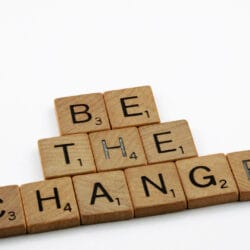You may hear the term Changemaker a lot on Richly Wills, but what exactly do…
What is design thinking? How to utilize it? Why it’s so important to think this way for our future? This complete guide to design thinking explains all.
This Complete Guide Was Put Together By Richly UXD, a design thinking agency that helps clients challenge problems from a new direction.
By now many people will have heard the term ‘design thinking’. Some may have even put it on their CVs as a useful buzzword that seems hard for prospects to cross-examine any true expertise (along with the likes of ‘user experience’ and ‘good communication skills’), but others may still be wondering what on earth it actually means, and why it’s deserving of a ‘complete guide’.
Well, let’s dive in and find out.
What Is Design Thinking Is?
Only a decade or so ago the term ‘design thinking’ had barely been heard, but the principle behind the term has had foundations laid for many decades. It’s only recently become more mainstream as the world has changed to give precedence to such processes.
The term design thinking came about in the last couple of decades, but the principle behind what the term stands for has been around much longer.
How The Design Thinking ‘Iterative’ Process Works (And Doesn’t)
(why you can’t force creativity with logical processes like clocks).
How To Think Like A Design Thinker
Design Thinking At Work: Inspiration, Ideation, Implementation & Iteration
Design Thinking In Daily Life
The Future Of Design Thinking
The Difference Between Design Thinking And User Experience
People get something fixed in their minds and even if it’s wrong don’t adapt as it’s easier to stick with what they know – but design thinkers expand beyond sticking with that comfort, they challenge it, it’s AQ versus EQ when we consider design thinking versus user experience. While it’s important to have a good experience and EQ is important for determining empathy, we have to move beyond comfort thinking in order to solve more wicked problems that promote challenges, and it’s this that design thinkers are good at, and where UX designers might not venture to.
Design thinking is not about simply following a logical process to solve problems. There’s always an issue when a new ‘system’ comes to be. People end up thinking it’s the answer, the bible to follow, and this very belief stops them from thinking for themselves. The iterative process is absolutely not meant to be a fixed approach, so when you see many diagrams that explain what the design thinking process is it does not mean you should implement it like an instruction manual. The reason being is that part of the iterative approach needs an open mind to look at problems differently, and you can’t do that if your mind becomes fixed to a set way of doing something. What is needed is an intuitive approach to change and adapt the process as is needed.
The idea that you simply go to design thinking school, graduate, have a certificate to say you can do it, and then apply for a job and call yourself a design thinker or user experience designer is frankly nonsense. It might work in more linear paths like accountancy and law but a design thinker is anything but linear in thought-process, and some of the best natural design thinkers around the globe are not within traditional forms of education or corporate work, and if they do fall into that it doesn’t take too long before they inevitably lose themselves to the role of systematic processes, whereby they likely spend their days explaining what design thinking is to those who don’t get it, and spend less actual time design thinking themselves.
Children are in some aspects the best design thinkers, at least in the solution-based aspect. They have the advantage of seeing the world without a fixed constraint that becomes more ingrained and biased within adults. They haven’t practiced something 100 times to find the ‘right’ way to do something. They are innocently naive in that respect, but that naivity helps them from thinking only with logic. Instead, their imagination shines.
Although kids don’t have the refined methods of developing workable solutions yet, which is something that does become refined with practice and experience. So, is the answer to let the kids come up with ideas and the constrained adults then work out all the reasons why it doesn’t work? Well, we see how over disciplining children works, or more to the point, doesn’t work. It’s the precursor to turning your own child into a good working robot void of original ideas. It may sound safe to follow such regimented approaches and to avoid your child growing up as a rebel without a cause, but often the opposite is the result. Restrain someone of their natural needs to express their imagination for too long and their electrical connections simply stop firing (flight) or they oppose the control and rebel more against it (fight). When we bring our kids up in this way we aren’t making thinkers out of them, we are creating fear within them to think at all.
There are many well-to-do parents out there who restrict their own child’s potential unknowingly because so many jobs in the past required that specialist mindset to turn up, do a job, repeat, climb a ladder, lose your soul in the process.
Today the whole surrounding environment is changing though. For a child to grow up without developing their more creative side is going to be a disadvantage in the future adaptable workforce.
Not-to-mention that children actually need to rebel somewhat to find their own independence – the problem being is that our safety in independence is found in being agreeable more than disagreeable. That is clearly very good for empathy and in social connection, but it’s actually pretty bad for us in terms of developing the more innovative problem-to-solution based mindset – again a reason why a lot of the best thought leaders and design thinkers out there don’t follow the more agreeable paths in society.
Mastery is about the intuitive and passionate senses within, the years of learning and putting ourselves into something, but being able to adapt and change to changing environments. We need to change with the challenges that are presented to us. It’s not just EQ thinking though, as we need to think of design thinking as something beyond just simple journey mapping and user empathy. We don’t have to define the problem only through emphasizing what a user wants – like feedback that tells us they want to have robot hotel help and then it’s implemented and they realize it’s not humane, and it causes more problems and was only a selfish want or something they thought was cool because it wasn’t there before. We have to be careful about what we wish for at times, as it’s not just about being able to design think it, but to consider whether we actually need it or not – just because we desire something it doesn’t tell us whether that thing is actually just part of our own environmental conditioning or bias – to be thinking beyond our own bias we have to think beyond our own breed and ego, to think of the value something creates to humanity instead. Social media has been a truly world-changing tool but there’s also a lot of dangers and concerns with how it is killing people’s abilities to interact and think for themselves properly. Creating video games might be wanted by many teens but does it mean we should create them if they are damaging our brain cells? Companies may want to sell products that are popular, and we may fall for the tipping point theory at times to popular trends and opinions, but it doesn’t mean the companies are automatically going to create something sustainable or even ethical.
Link to the new book – Throw Away The Comfort Blanket.
How design thinking differs from User Experience
Most design agencies have the concept of empathy running at their core today, but we know that simply aligning with customers wants or making design more user friendly isn’t enough to help people adapt to future changing environments or cater for humanities deeper needs.
We believe we have a social responsibility to design ethical, future-led, sustainable solutions (read more here) that go beyond user experience (although we do that too).
Of course we do that too, but as Richly Wills helps teach, we can’t rely on staying inside the same box of thought patterns to develop new solutions. We have to adapt our minds and not focus on IQ or EQ but on AQ.
we very much focus on the space and interaction, as well as the needed aspect of whether your user will benefit. We help you create solutions that your customer will need. SME businesses and startups look at
You make more money because of the time and energy saved on wasteful marketing practices before knowing what is needed, and because less waste is created by thinking about problems sustainably.
The concepts we develop with our clients help you think beyond today, but into what people and our planet will need tomorrow.
we don’t just have customers, we help people, and it’s these touches that people remember and return for, and this is especially true for local SME businesses.
Design thinking is not the same as user experience. It is about solving-problems first so that we can then iterate better user experiences as a result.
solving wicked social innovation problems. In local businesses we can see many issues when we look for them.
We have been asked to help in a variety of both conceptual and solutions based work, ranging from coming up with a way to improve a flow of traffic from a main motorway, to
This can be on a local business scale where you think ahead of your competition
But, around the turn of the century, they found that their clients reached out to them for solving problems such as organizational design, business, marketing issues in the company – problems which does not come under any traditional purview of Design. The reason for that is because designers have a different approach to problem solving(more human-centered, behavior-focused etc) and sometimes they were able to come up with very innovative solutions and perspectives to problems outside of traditional “design”.
Design thinking helps us go beyond the current constraints of industry standards and to disrupt and look at things differently to develop solutions to ‘wicked’ problems that people may face.
Impacting design thinking solutions don’t seek to make people comfortable, lazy, or even feel manipulated to buy, we aim to develop solutions that engage our real-world experience and enhance our life.
When we focus on developing ethical solutions that consider what people need and how they adapt, and not just what people think they want, we don’t just have customers, we help people, and it’s these touches that people remember and return for, and this is especially true for local SME businesses.
People get something fixed in their minds and even if it’s wrong don’t adapt as it’s easier to stick with what they know – but design thinkers expand beyond sticking with that comfort, they challenge it, it’s AQ versus EQ when we consider design thinking versus user experience. While it’s important to have a good experience and EQ is important for determining empathy, we have to move beyond comfort thinking in order to solve more wicked problems that promote challenges, and it’s this that design thinkers are good at, and where UX designers might not venture to.









